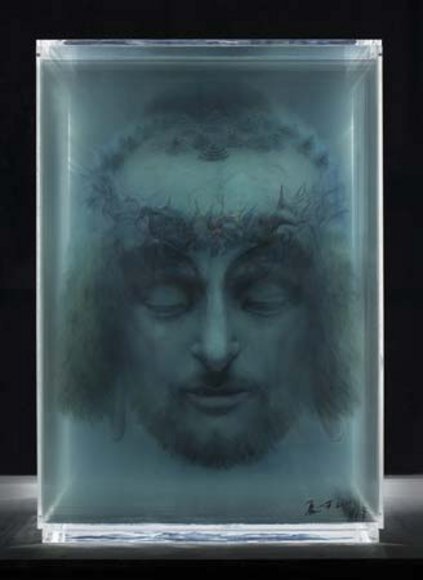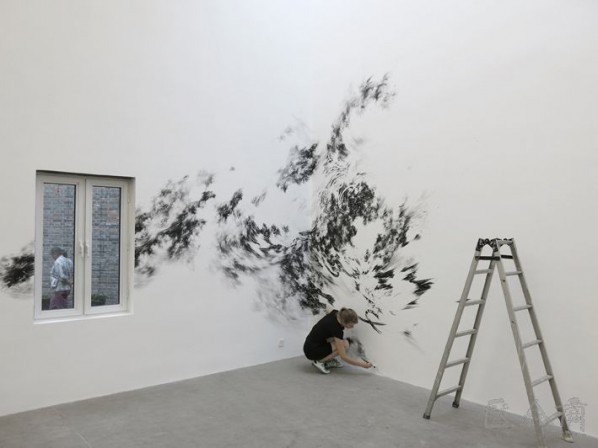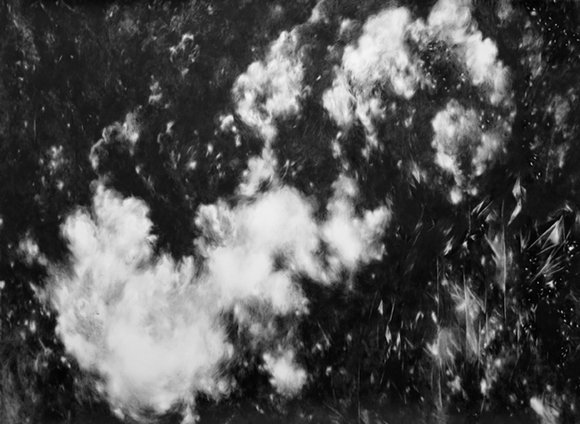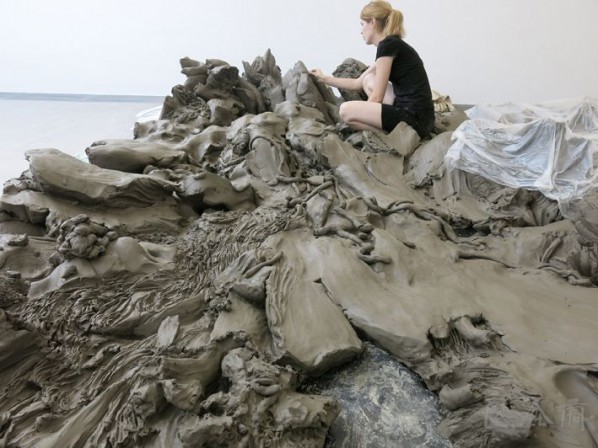
Xia Xiaowan, Sketch-Leonardo da Vinci No.2, 2013; special pencil, 24 tinted glass panels, ech 6 mm thick, 60.5x40.0cm(glass), 66.5x44x42cm(framed)
Galerie Urs Meile is pleased to announce the opening of a solo exhibition by Xia Xiaowan. While viewers might be familiar with his earlier glass works, in this exhibition these three-dimensional works are juxtaposed with related sketches, revealing the artists exploration and understanding of process in painting. In his earlier artistic practice, Xia Xiaowan primarily produced pencil drawings on paper. But in order to establish a more close relationship between the works and the exhibition space, and drawing on concepts developed in his earlier paintings on glass panels, Xia began in 2003 the transition from two-dimensional drawing to three-dimensional painting. These glass works, with their stereoscopic optics, broke the boundaries of two-dimensional paintings and created a strong sense of physical mass that was at the same time empty and ambiguous. The exhibition presents a selection of four representative three-dimensional works, shown together with sketches related to his artistic process, to provide the viewer with a means of understanding his transition from a traditional painting form to a three-dimensional object.
In the center of the gallery space, a glass piece combines representations of Jesus and Buddha that relate to Xia Xiaowan’s earlier statue series. In terms of visual effect, the artist humorously conflates the supreme beings of the Western and Eastern worlds into one; in terms of the cultural connotations, it reflects the essence and differences between two cultures. In addition, based on the existent images, the artist continues to create a variety of figures, which are also included in the exhibition.

Xia Xiaowan, Portrait of the Other #13 Sketch, 2010; Pencil on paper, 35.5x27.5cm

Xia Xiaowan, Portrait of the Other #13, 2011; special pencil, 37 tinted glass panels, each 6 mm thick, 81.5x59cm(glass), 88x60.5x69.5cm(framed)
The human body has been an artistic research interest in Xia Xiaowan’s work for a long time, and it is taken up again in Two Persons in Water (2012, special pencil, 26 tinted glass panels, each 6 mm thick, 60.5 x 82 cm (glass), 67.8 x 51 x 83.5 cm (framed)). By referring to the works on paper, the audience can appreciate the efforts made by the artist in exploring form; he achieves the effect of “being like something and yet not being that thing you’re like,” and finds the point between the true and the untrue. Superimposing or layering a series of sketches is a formal strategy used by Xia Xiaowan. In the two-dimensional works there is already a sense of layering present, while the three-dimensional works bring this into full play. In one of the pieces, the artist combines multi-layered beards with handwritten manuscripts by Leonardo da Vinci, bringing together complex elements that explore the possibilities in creating shape.
In addition to the human body, landscape is another key theme in the artist’s work. Xia Xiaowan explores the topic of space in these landscape paintings, creating a dialogue that transcends time and space with the classics of Chinese traditional art. In the exhibition, we deconstruct the piece Chinese Ancient Landscape of Fan Kuan Linliuduzuotu (2014, special pencil, 20 tinted glass panels, each 6 mm thick, 81.5 x 57.5 cm (glass), 88 x 59 x 47 cm (framed)) showing the glass panels one by one, and provide an opportunity for the audience to observe the three-dimensional work’s components in isolation.
Born in Beijing in 1959, Xia Xiaowan currently lives and works in Beijing. His works have been exhibited all over the world. Main solo exhibitions include Transmutations across the Space – XIA XIAOWAN Solo Exhibition at MOCA@Loewen in Singapore in 2012; Xia Xiaowan – Three Dimensional at Galerie Urs Meile Lucerne Gallery in 2010; and How do You See with Your Mind & Body? Xia Xiaowan’s Works on Paper at the Today Art Museum in 2003. Recent group exhibitions include Face Art Exhibition at the Minsheng Museum in Shanghai in 2012; and Reshaping History – China from 2000 to 2009 at the China National Convention Center (CNCC) in Beijing, China in 2010.
About the exhibition
Duration: September 6 - October 19, 2014
Opening: Saturday, September 6, 2014; 4 - 7pm

Carol Yinghua Lu on the occasion of Julia Steiner’s solo exhibition deep voice – clear sky 净空 – 深声 at Galerie Urs Meile, Beijing:
Basel-based Swiss artist Julia Steiner might yet to become a familiar name to many of us in the Chinese art world, but she is no stranger to China. She has spent extensive time and energy traveling and working in China, through two artist-residency stays in Galerie Urs Meile in Beijing. What brought her to China in the first place was the fact that when she started out making works on paper and showing her gouache paintings back home in Switzerland, one of the most common responses she received was that many in Europe thought she was influenced by Chinese traditional paintings. It was then that she began reading about Taoism and learning about Taoist thoughts through the works of Laozi and Zhuangzi. As she read more, she made a decision to come to China and to see it for herself.
Composing a painting or an installation through collaging and by responding intuitively, sensually and aesthetically to physical conditions and atmospheric surroundings of a space has been a systematic approach in Steiner’s practice. The paper she paints on and the process of making each painting are the connected-links between how she witnesses and experiences a space or a condition and how she articulates such an experience. She drew situations, persons, fragments of situations, sights and scenes. The process of working through a painting is a process of recalling and conveying a personal immersion in a situation, be it darkness or an empty space. As the artist describes it herself, it is as if taking a walk through a painting.

Julia Steiner, Last Light, 2014; gouache on paper, 205x240cm

Julia Steiner, O.T., 2014; gouache on paper, 150x205cm
In the early paintings she made around 2005, what emerged as motifs were usually a mixture of things: observations, noise she heard, scenes she witnessed, sentences she heard or read, atmosphere she felt in a space. These were inspirations she would start with and she would then try to find an image for their materialization on paper. It was usually not a clear idea of the actual image, but more of a feeling of what the image was and how it should look like. These images in her work were more imaginary than factual, yet firmly based on the reality as she experienced it. Instead of portraying birds fluttering around in the space, resting on a tree or horses running, literally as they appear, what Julia Steiner sets out to do in her painting is to make apparent the experience as such.
Until now, Steiner always works in black and white. In her paintings, the majority of which are done in large scale, whiteness is almost always more expressive and outstanding than blackness and is nearly inevitably the first thing that catches one’s eyes. In a way, Steiner is sculpting space and void in her works, a process motivated by her experience and memory of the reality, her personal reality, to be precise, paths she takes, places she visits, sound she hears and scenes she witnesses. It’s both personal and original. She does not take references from theoretical writings or precedents from art histories. I asked Steiner if having being in China a number of times, doing research and making works, had she come to agree with any of the resemblance and connection people back home talked about between her paintings and Chinese paintings. She told me that in fact shortly after arriving in China, she knew that such a generalization about Chinese paintings and the formal comparison between hers and Chinese traditional cultures were just irrelevant.

In the exhibition at Galerie Urs Meile, Beijing during the installation process, Julia Steiner has brought in 3500 kg of wet clay to the gallery space and worked on them for seven days on a wood base, measured at 3.20 m wide and 4.10 m long with a height of 28 cm, built especially to hoist this sculptural being. She also made a painting on the walls of the exhibition space, framing the sculptural work. Like her paintings, the clay work requires the artist to be with it, spending time observing, molding, feeling and making it, taking some distance from it and returning to it. After a two-week breathing period, the artist will cover it with black glossy acrylic paint. This enormous and abstract clay landscape will continue to dry during the time being of the exhibition and will crack, change form and become a living presence in the space. This new direction of working with clay does offer a more corporal feeling, the experience of the density and the energy of the artist’s movement in full dimensions and from all angels.
About the exhibition
Duration: September 6 - October 19, 2014
Opening: Saturday, September 6, 2014; 4 - 7pm
Courtesy of the artists and Galerie Urs Meile, for further information please visit www.galerieursmeile.com.




























